11 Types of Sundials to Enjoy Tracking Time the Old Way
Author: Rick Worst | Editor: Omar Alonso
Review & Research: Jen Worst & Chris Miller
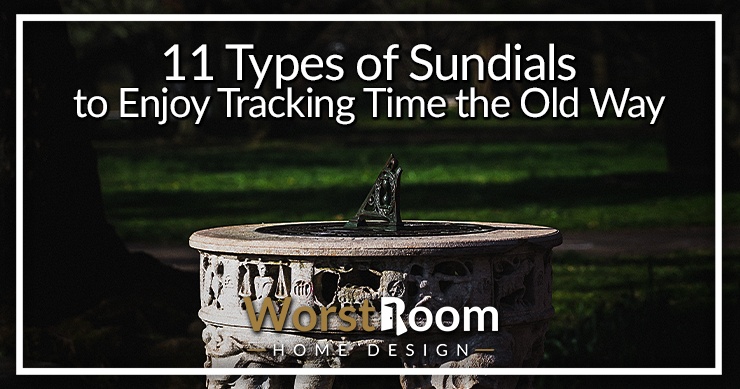
Among the oldest scientific devices known to humankind, the different types of sundials have been around since 1500 BCE, built by some very smart members of the Egyptian community. The first sundial was as basic as it gets—shaped like an ‘L’ with vertical and horizontal legs to cast shadows.
While the shape, structure and concept remain largely unchanged, sundials are no longer the primary source of time-telling—they’re also classy garden adornments, right at the top with fountains, birdbaths and garden gnomes.
These devices, apart from being a fun science experiment, add an excellent antique touch to any space. The history of sundials adds more allure to them.
11 Types of Sundials
Sundials come in two main types—altitude and azimuth dials. Here’s a breakdown of the different types of sundials, whether you’re interested in the science or the aesthetic value of owning some of the first types of clocks ever.
Equatorial Sundials
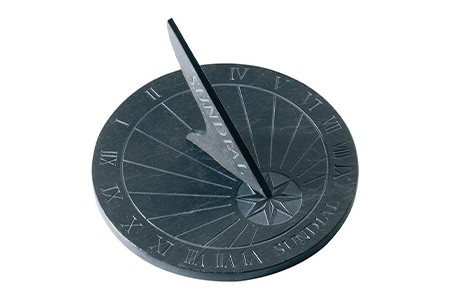
Let’s start with Equatorial sundials, sundials that earn their name from being parallel to the Earth’s equator as well as the equator of the celestial sphere.
Also known as equinoctial and universal dials, Equatorial sundials are a kind of Azimuth sundial, which means that they tell the time through the sun’s direction or angle in its daily journey across the sky.
Equatorial sundials are believed to be among the easiest sundials to build—all you need are a flat surface aligned to the celestial equator and the indicator or ‘gnomon’, whose shadow is cast on the flat surface, aligned perpendicular to the celestial equator.
The unique feature of Equatorial sundials is that they have a completely flat ‘planar surface’, so the shadow of the gnomon that is cast on them is always exactly perpendicular to the gnomon.
Equatorial Ring Sundials
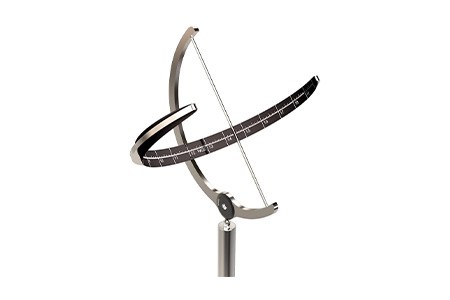
These are a type of Equatorial sundial, where the hours are marked within a partial or complete ring, instead of a solid flat plate.
However, you won’t be able to tell the time with these types of sundials if you’re near the equator since the equatorial ring’s upper half casts shadows that completely cover the markings on the sundial.
Polar Sundials
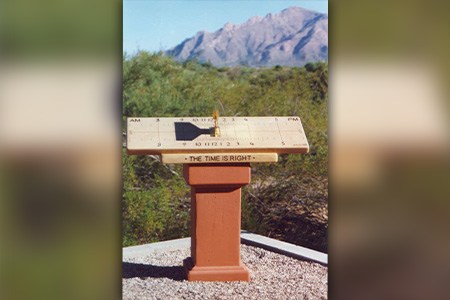
In polar sundials, the dial plate is set parallel to the polar axis or in an inclined East-West position. The gnomon and the hour lines on these sundials are parallel to the dial plate and each other, respectively.
One of the essential features of a polar sundial is that the face of the sundial be parallel to the gnomon, even if it isn’t necessarily vertical. These sundials are generally made of rectangular plates or installed on rods.
In a polar sundial, the inclined East-West position makes the shadow move in a perpendicular direction with the sun’s rotation, sliding sideways on the surface.
When the sun’s rays and the plane of the dial align in parallel, the shadow moves very quickly as the parallel hour lines end up spacing far apart. Polar sundials also begin to the Azimuth family.
Horizontal Sundials
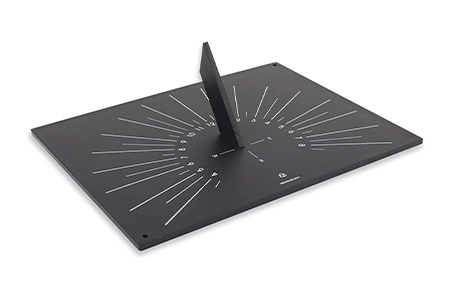
Horizontal sundials are probably the most commonly found sundial, distinguished by the prominent flat dial plate. They read as well as a clock or wrist watch all without needing any types of springs.
These sundials are also known as ‘garden sundials’, thanks to their presence on many garden pedestals around the world. These are also the easiest to decipher—all you need is the sunshine to be able to easily tell the time.
Horizontal sundials are generally made of wood—a rigid, weatherproof material—as they need to withstand the weather elements outdoors.
The hour markers, gnomon and faceplate are the three major parts of horizontal sundials. With horizontal sundials, adjustment for various latitudes is required—you can’t use the same dial in two different zones.
It depends on the angle of the gnomon—if the gnomon is set at 55 degrees, these types of sundials are designed for use at a latitude of 55 degrees.
Vertical Sundials
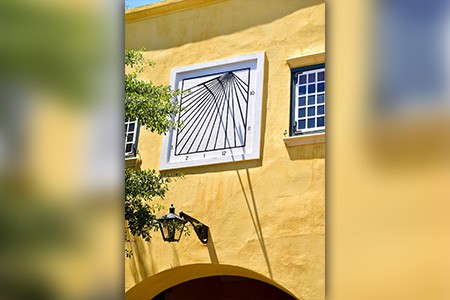
If there are horizontal sundials, vertical sundials can’t be far behind, right? Vertical sundials, as the name suggests, are vertical, which is why they’re found mounted and adorning the walls of many buildings around the world.
The gnomon on these is aligned to the earth’s rotational axis while the faceplate is aligned vertically.
Vertical sundials are common sights on cupolas, town halls, churches and other old building facades. These can even be used as substitutes to clock towers, placed on all four sides of a regular tower, easy to spot from a distance and accurately telling the time.
A distinguishing feature of these sundials is that the shadow line doesn’t move uniformly on the faceplate. The gnomon is often just a single metal bar but it can also be a tripod of metal bars—the latter provides more rigidity.
The gnomon’s angle, horizontally, aligns with the altitude angle of the sundial’s geographical location, while pointing in the direction of the true North. Vertical sundial types, along with horizontal sundials, are Azimuth dials.
Digital Sundials
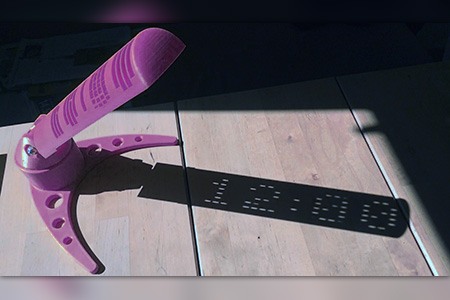
These sundials are new-age innovations and like most everything else today, are digital. These sundials display information in digits—some of the fancier ones also use pictures and words.
Digital sundials are a great example of modern and ancient technology coming together to create an innovative, efficient product. These sundials use a pair of masks, spaced in parallel, that display different images. The image projected depends on the sun’s angular position.
The first mask casts a usually striped pattern of light on the second mask, depending on the sun’s height. The second mask contains narrow digit stripes that it displays later.
The stripes and pattern of both masks match, resulting in an image that shows the actual time. Digital sundials work like digital clocks, displaying time in digits, as mentioned earlier.
These sundials do have their own set of limitations—they can’t work at night and the time can only be told in intervals of 20 minutes. Ergo, there is a higher margin of error and you may not always get the correct time.
Digital types of sundials are a type of altitude dial. This means that they use the sun’s altitude to tell the time or its height above the horizon.
Cylindrical Sundials
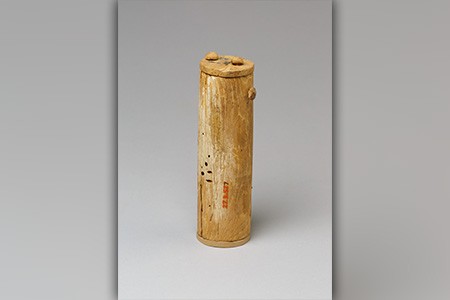
Cylindrical sundials go by many names—pillar, shepherd’s, pole and portable cylinder sundials. They were initially only carried around by shepherds, which also earned them the name ‘traveler’s dial’.
Cylindrical sundials work on the principle of the sun reaching different heights, at different hours of the day, on different days of the year.
These sundials have a cylindrical body, with a gnomon placed on the movable top. The cylinder’s main body has hour lines printed on it in the form of inscribed curves.
The sun’s height is measured by the gnomon casting a shadow. The shadow represents the correct hour by matching the sun’s given height.
These sundial types have a horizontal division to display the months and days of the year, while the vertical division indicates the time. To determine time correctly, the gnomon is set over a vertical line and the time is exactly where the shadow of the gnomon’s tip falls on the hour line.
One thing to remember is that cylindrical sundials can only correctly tell the time for the latitude at which the dials have been prepared and adjusted for. Cylindrical sundials belong to the family of altitude sundials.
Analemmatic Sundials
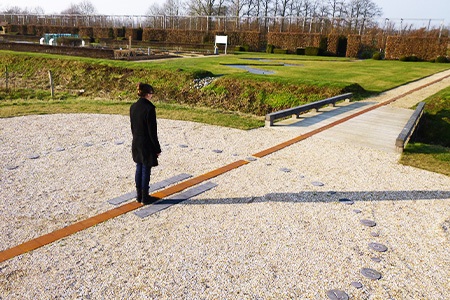
Analemmatic sundials are a type of horizontal sundial, except for the presence of a vertical gnomon. These are also called vertical center dials.
A distinguishing feature in these different types of sundials is that the gnomon doesn’t hold a fixed position—it needs to change daily to be able to tell the time accurately.
It is due to this reason that there are no lines on the faceplate of this dial—the time can only be read on the ellipse; the hour markers are also positioned elliptically.
The size of the ellipse, the location’s latitude and the sun’s declination are the three main features of the analemmatic sundial.
The latitude of the location helps identify the position of the hour markers on the ellipse, whereas the declination of the sun determines the position of the gnomon every day.
This sundial’s vertical gnomon is movable and its daily position depends on the date. The points on the dial’s elliptical circumference indicate the total hours of the time. Analemmatic sundials are also altitude sundials.
Reflected Ceiling Dials
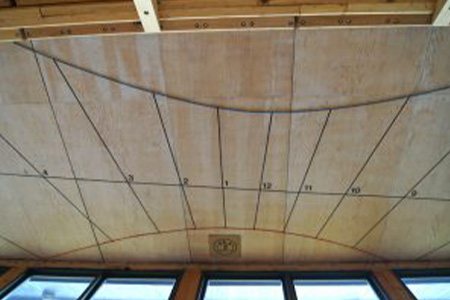
These uncommon sundials consist of a horizontally laid out mirror on a north-facing window sill for the residents of the southern hemisphere or on a pole outside the window for the rest of us.
The hour lines, resembling slightly distorted ‘8’ figures, are drawn on the ceiling. The sunspot tells you the date and the time.
Ring Sundials
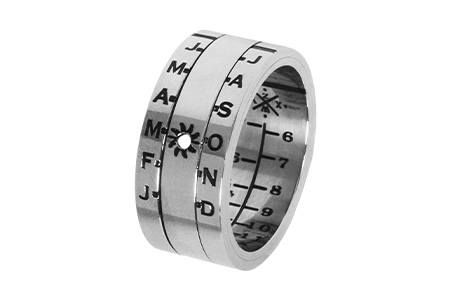
Also called armillary sundial types, ring sundials use the light, instead of shadows, for time-telling purposes.
The ring has hour lines marked on the inside and each hour line has a tiny hole through which the sunlight enters to fall on the ring. It is necessary that the ring be turned on so that the light falls on the correct dateline.
Earlier ring sundials were quite small, generally with a diameter less than 25 mm, which, needless to say, made it quite Herculean for people to correctly read and identify the time displayed. This led to the creation of bigger models, with diameters reaching 10 cm.
Jewel Sundials
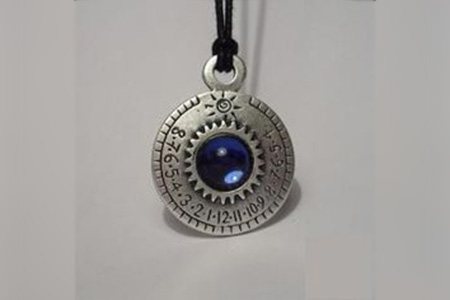
Yep, sundials can also feature in jewelry. While there is the endeavor to perfectly tell the time present, these sundials are most often simply decorative and not very accurate.
Types of Sundials for Every Eclectic Taste
We get it—differentiating between sundial types can come down to the technicalities and the science of it.
However, most types of sundials look very different from each other, which is an easier way to tell them apart. Unless there’s a scientific reason behind wanting a sundial, stick to a horizontal sundial, especially if it’s just for adornment purposes.



